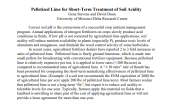Hang on there a second..
@Derek Reese 29 - Are you spreading pelletized lime? Most soil tests are typically based on Ag lime. Pelletized lime has a
much better ENM than most sources of Ag lime due to its particle size. Most references say around 1:10 ratio, albiet this is a shorter term solution with pelletized lime.
So, if your soil test says 2 tons (4,000#) - they are typically assuming a ENM of 2,000 (maximum rating). My local lime has an ENM of around 780 for example. So, if I'm using..
Ag Lime: 4,000# * 2,000 Max ENM / 780 Actual ENM =
10,256# / Ac
Pell Lime: 4,000# * 0.1 =
400# / Ac
Like below:
View attachment 41451
Now the
long term effectiveness of pelletize lime vs Ag lime is also quite different. 1-2 years max for pelletized lime, but 5-7 years for Ag lime. It will depend on the CEC rating of your soil, annual rainfall, etc..
Spread the next time the ground is firm enough your tires don't sink in. Let fly.
![IMG_5782[1].JPG IMG_5782[1].JPG](https://habitat-talk-data.xenforo.cloud/attachments/41/41422-fd333dc0d4505f9833366c7d13934b6f.jpg?hash=_TM9wNRQX5)
![IMG_5782[1].JPG IMG_5782[1].JPG](https://habitat-talk-data.xenforo.cloud/attachments/41/41422-fd333dc0d4505f9833366c7d13934b6f.jpg?hash=_TM9wNRQX5)


